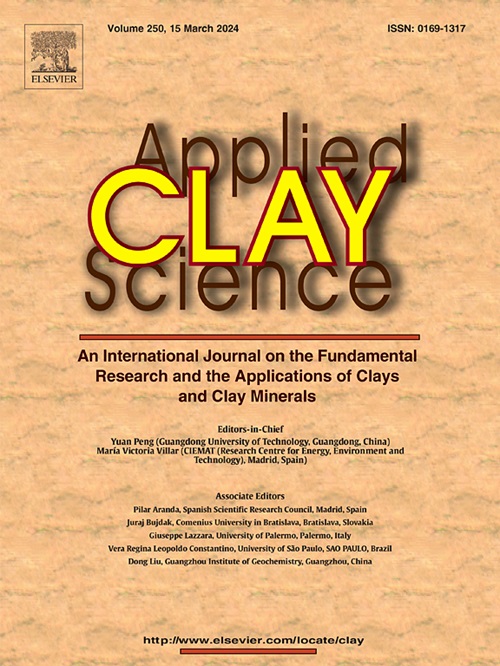Growth mechanism of long-period biotite polytypes in the Long Valley magmatic system: A non-equilibrium crystallization model
IF 5.3
2区 地球科学
Q2 CHEMISTRY, PHYSICAL
引用次数: 0
Abstract
Polytypism in minerals, particularly in phyllosilicates, holds significant interest as it reflects geochemical conditions. Short-period, such as 1 M, 2 M1 and 3 T polytypes are commonly found in micas across sedimentary, igneous, and metamorphic rocks. In contrast, long-period/complex polytypes predominantly occur in extrusive systems, these correlations remain subject to ongoing debate. Various mica polytypes, particularly biotite polytypes, have been frequently proposed as potential indicators of magmatic or hydrothermal crystallization environments, though this interpretation remains inconclusive. This study provides in-situ micro-nanoscale evidence to elucidate the genesis and crystallographic growth mechanisms of long-period/complex polytypes in biotite using transmission electron microscopy (TEM). Numerous biotite phenocrysts from rhyolites of the Long Valley caldera (California, USA) were examined, identifying abundant polytypes, including common (i.e., 1 M, 2 M1 and 3 T), long-period (4, 5, 6, and 15- layers repetition) and complex polytypes. The biotite phenocrysts display a core-rim zonation, with the core tends to develop ordered short-period polytypes, while the rim giving rise to long-period and complex polytypes. Our high-resolution TEM results suggest that long-period and complex polytypes might be fundamentally composed by more than two common polytype units, presenting a dense dislocation network along the (001) plane of biotite. In the context of equilibrium crystallization producing short-period ordered micas and non-equilibrium crystallization enabling oriented attachment (OA), a crystallization model for the formation of long-period/complex polytype biotite under non-equilibrium conditions was proposed. In this model, the crystallization of long-period/complex polytypes occurs in steps: (1) multi-ion complexes forming different nanoparticles (polytypes) who nucleate simultaneously due to a chemically and structurally fluctuation in the non-equilibrium crystallization environments; and (2) long-period polytypes are formed through the assembly between these different nano-crystals via OA and subsequent spiral growth along screw dislocation generated between the neighboring nanao-crystals. Our findings elucidate the potential origin and growth mechanism of long-period/complex biotite polytypes under non-equilibrium crystallization conditions such as magmatic systems. The proposed model offers a framework for non-equilibrium crystallization environments and insights into complex polytypes and interlayered clay minerals in diverse phyllosilicates and corresponding geological settings.
长谷岩浆系统中长周期黑云母多型的生长机制:一种非平衡结晶模式
矿物中的多型性,尤其是植硅酸盐中的多型性,反映了地球化学条件,因此具有重要意义。沉积岩、火成岩和变质岩中的云母中通常存在短周期的多晶型,如 1 M、2 M1 和 3 T。与此相反,长周期/复合多型云母主要出现在喷出岩体系中,但这些关联性仍存在争议。各种云母多型,尤其是生物云母多型,经常被提出作为岩浆或热液结晶环境的潜在指示物,但这种解释仍然没有定论。本研究提供了原位微纳尺度证据,利用透射电子显微镜(TEM)阐明了生物云母长周期/复合多晶型的成因和晶体生长机制。对来自长谷破火山口(美国加利福尼亚州)流纹岩的大量生物闪长岩表晶进行了研究,确定了丰富的多晶型,包括普通多晶型(即 1 M、2 M1 和 3 T)、长周期多晶型(4、5、6 和 15 层重复)和复杂多晶型。生物沸石表晶显示出核心-边缘分带,核心倾向于形成有序的短周期多晶型,而边缘则产生长周期和复杂的多晶型。我们的高分辨率 TEM 结果表明,长周期多晶型和复杂多晶型可能从根本上由两个以上的共同多晶型单元组成,沿生物钛铁矿的(001)面呈现密集的位错网络。在平衡结晶产生短周期有序云母和非平衡结晶产生定向附着(OA)的背景下,提出了一个在非平衡条件下形成长周期/复杂多型生物橄榄石的结晶模型。在该模型中,长周期/复合多晶型的结晶分几个步骤进行:(1) 由于非平衡结晶环境中的化学和结构波动,多离子复合物形成了不同的纳米粒子(多型),它们同时成核;以及 (2) 这些不同的纳米晶体之间通过 OA 组装,随后沿着相邻纳米晶体之间产生的螺旋位错螺旋生长,形成了长周期多型。我们的研究结果阐明了在岩浆系统等非平衡结晶条件下,长周期/复合生物陶瓷多晶型的潜在起源和生长机制。所提出的模型为非平衡结晶环境提供了一个框架,并有助于深入了解各种植硅体和相应地质环境中的复杂多晶型和层间粘土矿物。
本文章由计算机程序翻译,如有差异,请以英文原文为准。
求助全文
约1分钟内获得全文
求助全文
来源期刊

Applied Clay Science
地学-矿物学
CiteScore
10.30
自引率
10.70%
发文量
289
审稿时长
39 days
期刊介绍:
Applied Clay Science aims to be an international journal attracting high quality scientific papers on clays and clay minerals, including research papers, reviews, and technical notes. The journal covers typical subjects of Fundamental and Applied Clay Science such as:
• Synthesis and purification
• Structural, crystallographic and mineralogical properties of clays and clay minerals
• Thermal properties of clays and clay minerals
• Physico-chemical properties including i) surface and interface properties; ii) thermodynamic properties; iii) mechanical properties
• Interaction with water, with polar and apolar molecules
• Colloidal properties and rheology
• Adsorption, Intercalation, Ionic exchange
• Genesis and deposits of clay minerals
• Geology and geochemistry of clays
• Modification of clays and clay minerals properties by thermal and physical treatments
• Modification by chemical treatments with organic and inorganic molecules(organoclays, pillared clays)
• Modification by biological microorganisms. etc...
 求助内容:
求助内容: 应助结果提醒方式:
应助结果提醒方式:


